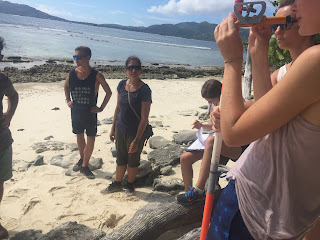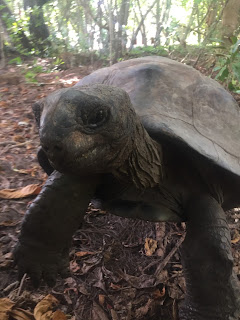This week was a new and exciting experience that makes me look forward to the beginning of the week tomorrow. I begun my week traveling to Curieuse and moving into my new home. The volunteers living on this island (to my surprise) live inside the buildings on the old Leper hospital. Living conditions are minimal, my section of the hospital that I live in has no doors, but I am not complaining because there is a wonderful ocean breeze at night that the more fortunate people with doors miss out on. The days begin with waking up at six, eating breakfast and heading out.
Monday (just my luck) I got scheduled to stay on base to cook, so I missed out but the following day, we trekked to Grand Anse to find the success rate of the turtle nests that should've hatched in the previous week. This was exciting because out of the 197 eggs laid, 195 of them hatched, which is an extremely high success rate in comparison to the 65% hatching success rate in the hawksbill sea turtle in the Seychelles. The interesting thing about the sea turtles in the Seychelles is that they are the only hatchlings in the world that hatch during the day due to the fact that their only predator is the land crab which is primarily nocturnal. I did get the chance to see some of the hatchlings make their way to the ocean and I've seen something so adorable! (pictures to come)
 On Tuesday, I spent the day in the mangroves, learning the different species and how they live and adapt with the change in sea water temperature. Next week, we will be putting in a Quad where as we measure an amount of space every 6 months to determine the change in species in that space to see those that are successful and those that are not.
On Tuesday, I spent the day in the mangroves, learning the different species and how they live and adapt with the change in sea water temperature. Next week, we will be putting in a Quad where as we measure an amount of space every 6 months to determine the change in species in that space to see those that are successful and those that are not.On Wednesday, I began my day with waking up at four o'clock in the morning in hopes to go catch a shark in order to tag it for the first time with a tag that allows you to track their movement patterns. Unfortunately, we were unsuccessful, but we plan to go out again on Monday morning to attempt on another shark. We did, however, get the chance to dissect a shark that didn't make it through the final stages of birth.
On Thursday, I spent my day measuring more beach levels on four on the different beaches on the island. Finally, on Friday, I spent my morning with a few other volunteers walking the Giant Tortoises back to their pen for the weekend and if you thought herding cattle was hard...

In the first week alone on this island I've learned so many things already. Not only am I learning about the wildlife and ecosystems but the other volunteers that I am working with are from all over the world so not only am I learning Seychellois culture but I am also getting a global education in a way. I am definitely excited to see what the next week has to bring.








